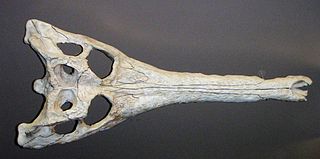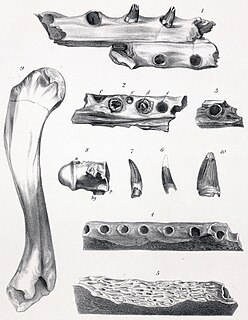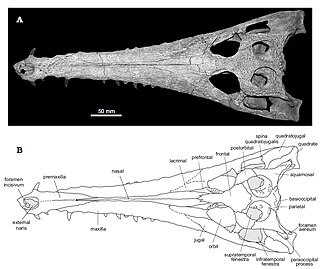
Gavialinae is a subfamily of large semiaquatic crocodilian reptiles, resembling crocodiles, but with much thinner snouts. Gavialinae is one of the two major subfamilies within the family Gavialidae - the other being the subfamily Tomistominae, which contains the false gharial and extinct relatives.

Toyotamaphimeia machikanensis is an extinct gavialid crocodylian which lived in Japan and Taiwan during the Pleistocene. A specimen recovered in 1964 at Osaka University during the construction of a new science building has been dated to around 430–380 thousand years old based on the stratum in which it was found. T. machikanensis was a fairly large crocodylian with a 1 m (3.3 ft) skull and a total length up to 7.7 m (25 ft). It was originally described as a member of the genus Tomistoma.

Gavialosuchus is an extinct genus of gavialid crocodylian from the early Miocene of Europe. Currently only one species is recognized, as a few other species of Gavialosuchus have since been reclassified to other genera.

Harpacochampsa is a poorly known Early Miocene crocodilian from the Bullock Creek lagerstätte of the Northern Territory, Australia. The current specimen consists of a partial skull and fragments of a long slender snout reminiscent of that of a false gharial, demonstrating that it was a piscivore in life.

Megadontosuchus is an extinct monospecific genus of gavialoid crocodylian, traditionally regarded as a member of Tomistominae, from the middle Eocene of Italy. Fossils have been found from Monte Duello in the province of Verona. The genus is currently monotypic, with the type and only species being Megadontosuchus arduini. The species was originally named in 1880, although it was assigned to the genus Crocodilius. The genus was first erected by paleontologist Charles C. Mook in 1955 along with the genus Kentisuchus, which was also first classified as Crocodilius. No holotype for Megadontosuchus was designated in 1880, and a lectotype wasn't proposed until 2007.
Dollosuchoides, colloquially known as the Crocodile of Maransart, is an extinct monospecific genus of gavialoid crocodilian, traditionally regarded as a member of the subfamily Tomistominae. Fossils have been found in the Brussel Formation of Maransart, Belgium and date back to the middle Eocene.

Dollosuchus is an extinct monospecific genus of tomistomine crocodilian originally named as a species of Gavialis. It is a basal form possibly related to Kentisuchus, according to several phylogenetic analyses that have been conducted in recent years, and is the oldest known tomistomine to date. Fossils have been found from Belgium and the United Kingdom. It had large supratemporal fenestrae in relation to its orbits, similar to Kentisuchus and Thecachampsa.
Eogavialis is an extinct genus of eusuchian crocodylomorph, usually regarded as a gavialoid crocodylian. It superficially resembles Tomistoma schlegelii, the extant false gharial, and consequently material from the genus was originally referred to Tomistoma. Indeed, it was not until 1982 that the name Eogavialis was constructed after it was realised that the specimens were from a more basal form.
Eothoracosaurus is an extinct genus of eusuchian crocodylomorphs which existed during the Late Cretaceous period. Thoracosaurs in general were traditionally thought to be related to the modern false gharial, largely because the nasal bones contact the premaxillae, but phylogenetic work starting in the 1990s instead supported affinities within gavialoid exclusive of such forms. Even more recent phylogenetic studies suggest that thoracosaurs might instead be non-crocodilian eusuchian.

Eosuchus is an extinct genus of eusuchian crocodylomorph, traditionally regarded as a gavialoid crocodilian. It might have been among the most basal of all gavialoids, lying crownward of all other known members of the superfamily, including earlier putative members such as Thoracosaurus and Eothoracosaurus. Fossils have been found from France as well as eastern North America in Maryland, Virginia, and New Jersey. The strata from which specimens have been found date back to the late Paleocene and early Eocene epochs.

Kentisuchus is an extinct genus of gavialoid crocodylian, traditionally regarded as a member of the subfamily Tomistominae. Fossils have been found from England and France that date back to the early Eocene. The genus has also been recorded from Ukraine, but it unclear whether specimens from Ukraine are referable to Kentisuchus.
Maroccosuchus zennaroi is an extinct gavialoid crocodylian from the Early Eocene of Morocco, traditionally regarded as a member of the subfamily Tomistominae.
Paratomistoma is an extinct genus of gavialoid crocodylian. It is based on the holotype specimen CGM 42188, a partial posterior skull and lower jaw discovered at Wadi Hitan, Egypt, in Middle Eocene-age rocks of the Gehannam Formation. The skull is unfused but considered morphologically mature. Paratomistoma was named in 2000 by Christopher Brochu and Philip Gingerich; the type species is P. courti in honor of Nicholas Court, who found CGM 42188. They performed a phylogenetic analysis and found Paratomistoma to be a derived member of Tomistominae, related to the false gharial. It may have been a marine or coastal crocodilian.

Penghusuchus is an extinct genus of gavialid crocodylian. It is known from a skeleton found in Upper Miocene rocks of Penghu Island, off Taiwan. It may be related to two other fossil Asian gavialids: Maomingosuchus petrolica of southeastern China and Toyotamaphimeia machikanensis of Japan. The taxon was described in 2009 by Shan and colleagues; the type species is P. pani.

Thecachampsa is an extinct genus of gavialoid crocodylian, traditionally regarded as a member of the subfamily Tomistominae. Fossils have been found from the eastern United States in deposits of Miocene age. Those named in the 19th century were distinguished primarily by the shape of their teeth, and have since been combined with T. antiquus. More recently erected species were reassigned from other genera, although their assignment to Thecachampsa has since been questioned.

Tomistominae is a subfamily of crocodylians that includes one living species, the false gharial. Many more extinct species are known, extending the range of the subfamily back to the Eocene epoch. In contrast to the false gharial, which is a freshwater species that lives only in southeast Asia, extinct tomistomines had a global distribution and lived in estuaries and along coastlines.

Gavialis browni is an extinct species of the crocodylian genus Gavialis and a close relative of the living gharial Gavialis gangeticus.
Tomistoma cairense is an extinct species of gavialoid crocodilian from the Lutetian stage of the Eocene era. It lived in North East Africa, especially Egypt. Remains of T. cairense have been found in the Mokattam Formation, in Mokattam, Egypt. Tomistoma cairense did not have a Maxilla process within their lacrimal gland, whereas all extant (living) crocodilians do.

Maomingosuchus is an extinct genus of gavialoid crocodylian from Late Eocene of Southeast Asia. It was discovered in Priabonian-aged deposits of China and possibly also Thailand. The type species, originally Tomistoma petrolica, was named in 1958 and was redescribed as Maomingosuchus in 2017. A second species, Maomingosuchus acutirostris, was described in 2022 from middle-upper Eocence deposits of the Na Duong Basin in northern Vietnam. It is proposed to be a basal member of Gavialoidea, or alternatively within the family Tomistominae.

Gunggamarandu is an extinct monospecific genus of tomistomine crocodilian from Pliocene-Pleistocene aged deposits in the Darling Downs of Australia. Gunggamarandu represents the first tomistomine known from Oceania and it is also the southernmost known tomistomine to date. The type, and only known, species is Gunggamarandu maunala, which was described by Jorgo Ristevski et al. in 2021.
















